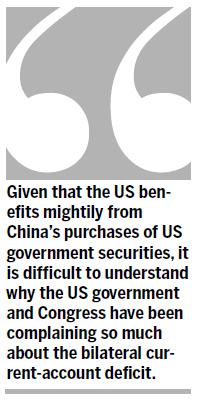Op-Ed Contributors
Balancing current accounts
Updated: 2011-02-25 07:55
By Yu Yongding (China Daily)

China's investment in US securities is of utmost importance for growth and financial stability of world's largest economy
Before July 2007, most economists agreed that global imbalances were the most important threat to global growth. It was argued that the United States' rising net foreign debt-to-GDP ratio - the result of chronic current-account deficits - would put a sharp brake on capital inflows, in turn weakening the dollar, driving up interest rates, and plunging the US economy into crisis.
But this scenario failed to materialize. Instead, the crisis stemmed from the US subprime debacle, which quickly dragged the global economy into its deepest recession since the 1930s.
Most economists failed to foresee the economic dynamics that actually led to the crisis, because they failed to pay enough attention to the rapid increase in US total debt. Instead, they focused exclusively on US foreign debt, ignoring household debt (mortgage and consumer debt), public debt, business debt, and financial debt.
In particular, they should have paid greater attention to the sustainability of US mortgage and consumer debt. In 2007, the mortgage and consumer debt-to-GDP ratio was more than 90 percent, compared to 24 percent for net foreign debt.
Of course, the various components of debt differ considerably in their character and sources of financing - and thus in their sustainability. But all parts of a country's total debt and how it is financed are interconnected.
This means two things. First, funds from different sources of finance are interchangeable to a certain degree: deficiency of funds for one component of total debt can be supplemented by surplus funds originally aimed at financing other components. Second, troubles in any single component of total debt will have an impact on all the other components.
After the subprime crisis erupted, mortgage and consumer debt was paid down by households either with their savings or by default. The fall in US total debt, and the narrowing of the financing gap between total debt and domestic funds, led to a significant improvement in the US current-account deficit in 2008-2009, disproving US Federal Reserve Board Chairman Ben Bernanke's claim that the deficit was caused by a global "saving glut". Indeed, America's current-account position strengthened despite the dollar's appreciation in the face of safe-haven demand.
Unfortunately, as a result of the private-sector deleveraging and an increase in household savings, the US economy, driven by debt and consumption, slid into recession. To offset the negative impact of private-sector deleveraging on growth, the US government has maintained expansionary fiscal and monetary policies. Now - with household debt sustained on a knife-edge after feverish government intervention- the fiscal position has deteriorated dramatically and the current-account balance has worsened again.
Sustainability of public debt has replaced sustainability of private debt as the biggest threat to financial stability, and the focus of debate about the US current account has shifted from the sustainability of foreign debt to the impact of reducing the external deficit on growth and employment. The dilemma facing US policymakers is how to stimulate growth while lowering the level of total debt.
The most important way to achieve both objectives is to increase exports by strengthening US competitiveness. But where will increased competitiveness come from?
Devaluation of the dollar could improve US competitiveness in the short run, but it is not a solution. Because rapid fiscal deterioration now has investors worrying about capital losses on US government securities, devaluation would make foreigners more hesitant to finance America's budget deficit. If foreign financing is not forthcoming, yields on US government debt will rise and the US economy will fall back into recession.
In the long run, the growth pattern of the US must undergo a structural shift from reliance on debt and consumption to one based on its vaunted capacity for creativity and innovation. Only then will the US improve its competitiveness enough to allow the government to reduce both private and public debt to sustainable levels while maintaining a respectable growth rate.
But neither improved competitiveness, nor reduction of total debt, can be achieved overnight. In the short run, the US current-account deficit will remain, regardless of which country runs bilateral surpluses.
Thus, China's continued reinvestment of its current-account surplus in US government securities is of utmost importance for US growth and financial stability.
Given that the US benefits mightily from China's purchases of US government securities, it is difficult to understand why the US government and Congress have been complaining so much about the bilateral current-account deficit. It is also difficult to grasp why China is so reluctant to reduce its bilateral surplus, given meager returns on its massive holdings of US government securities and a sustained risk of large capital losses in the future.
The good news is that, following President Hu Jintao's recent visit to Washington, both the US and China have been taking positive steps to resolve their differences over the bilateral current-account balance. That augurs well for a more rational and constructive Sino-US dialogue on global imbalances, which would certainly benefit the global economy.
The author is president of the China Society of World Economics.
Project Syndicate
(China Daily 02/25/2011 page8)
Specials

Kremlin buddies
Dmitry Medvedev and Vladimir Putin inspect Olympic preparations.

Lantern Festival
The Lantern Festival is celebrated across China.

New York Fashion Week
Models line up before a show during New York Fashion Week.